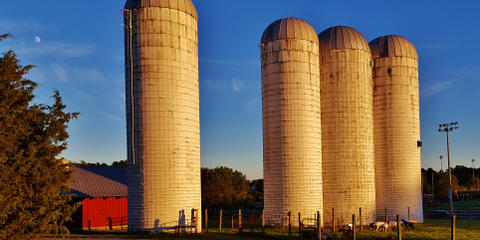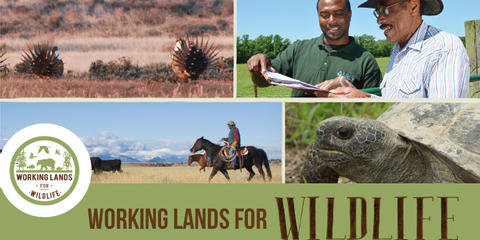Federal funding programs are under review as of 1/27/25. We'll make updates as new info is released.
Through Working Lands for Wildlife (WLFW), USDA uses a win-win approach to systematically target conservation efforts to improve agricultural and forest productivity which enhance wildlife habitat on working landscapes. Target species are used as barometers for success because their habitat needs are representative of healthy, functioning ecosystems where conservation efforts benefit a much broader suite of species.
Through the Farm Bill, NRCS provides technical and financial assistance to participants who voluntarily make improvements to their working lands while the US Fish and Wildlife Service (FWS) provides participants with regulatory predictability for the Endangered Species Act (ESA). This innovative approach empowers landowners with a means to make on-the-ground improvements and provides peace of mind that no matter the legal status of a species, they can keep their working lands working.
This model has proven extremely popular with private landowners across the United States. To date, WLFW has helped producers conserve more than 7.1 million acres of wildlife habitat and has helped many species such as the greater sage-grouse in the West and the New England cottontail in the Northeast. For both of these species — in large part because of voluntary conservation efforts on private lands — the FWS determined listing under ESA was not warranted. Beginning in 2017, NRCS expanded this model and now includes 19 landscapes covering 48 States.
Conservation Model
The conservation model builds on lessons learned in conservation over the years and includes:
-
Trust and Credibility: NRCS takes a community, grassroots approach to conservation that's based on the principles of neighborliness.
-
Shared Vision: NRCS-recommended conservation practices benefit both wildlife and agriculture.
-
Strategic Approach: NRCS invests resources efficiently, where the biological returns are the highest.
-
Accountability: NRCS and conservation partners use science to measure effectiveness of conservation and to quantify outcomes.
-
Leverage: NRCS brings together partners to multiply investments to achieve more conservation.
Regulatory Predictability: Through WLFW, NRCS partners with the U.S. Fish and Wildlife Service to provide regulatory predictability under the Endangered Species Act. Similar to an insurance policy, predictability provides landowners with peace of mind that no matter the legal status of a species, they can keep their working lands working with an NRCS conservation plan in place.
WLFW is currently active in 48 states, encompassing 19 different landscapes. Eight national and 11 state-identified species are used to focus individual projects that meet both the needs of the species as well as those of the agricultural operations. Individual species are used as barometers for healthy, functioning landscapes where conservation efforts also benefit a multitude of additional species as well.
Conservation efforts on private lands are making a difference across the country, from the sagebrush country of the West to the forests of Appalachia and New England. For these stories and many more, download the agency's WLFW magazine, A Partnership for Conserving Landscapes, Communities & Wildlife.
Application Instructions
To apply for one of the sub-programs under WLFW, reach out to your local NRCS service center.
Resources
Related Programs

Farm Storage Facility Loan Program (FSFL)
Farm Service Agency
- Loan
- Infrastructure
- Equipment
- Storage
- Lighting
- Delivery Vehicle
- National
- Oilseeds
- Peanuts
- Pulse Crops
- Hay
- Honey
- Biomass
- Fruits
- Vegetables
- Floriculture
- Hops
- Maple Sap
- Milk
- Cheese
- Yogurt
- Butter
- Eggs
- Rye
- Aquaculture
- Poultry
- Livestock
- Grains

A Climate-Smart Strategy for the Michigan Foodshed
Star of the West Milling Company, U.S. Department of Agriculture
- Grant
- Climate-Smart
- Beginning Farmers
- Women
- MI
- Wheat
- Dried Beans
- Soybeans

A Comprehensive Evaluation of the Impact of Industrial Hemp and Soil Microalgae Consortium as High-Efficiency Carbon Sequestration Model Plants
Florida A&M University, U.S. Department of Agriculture
- Grant
- Climate-Smart
- AL
- FL
- LA
- Hemp

A Multi-Faceted Approach to Incentivizing Woody Perennial Growers to Establish Cover Crops in Orchards in Four Diverse Regions of the United States
Agoro Carbon Alliance US, U.S. Department of Agriculture
- Grant
- Climate-Smart
- CA
- WA
- OR
- MI
- FL
- Fruits
- Tree Nuts
Details
Organization
Financial Instrument
Grant, Cost Share, Easement
Updated October 29, 2025
Image Credit: U.S. Department of Agriculture
This information was gathered from public sources. Ambrook is not responsible for or able to affect the results of any financial programs listed, nor are they responsible for any incorrect information that is listed or is on the hyperlinked external sites. All information is subject to change.
Explore hundreds more programs on Ambrook.
